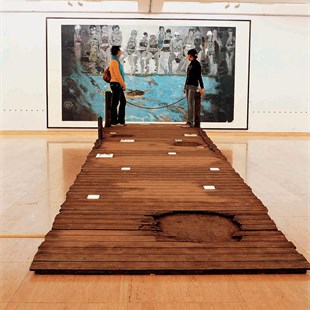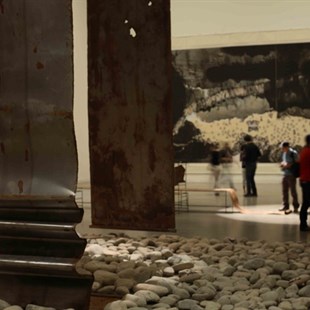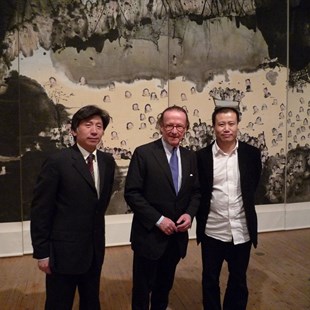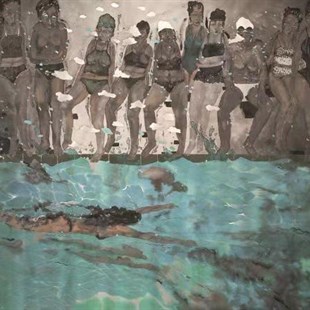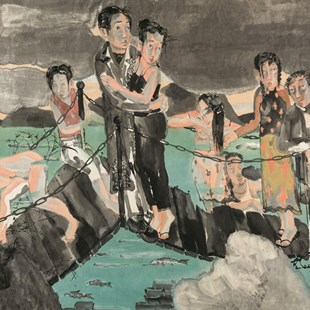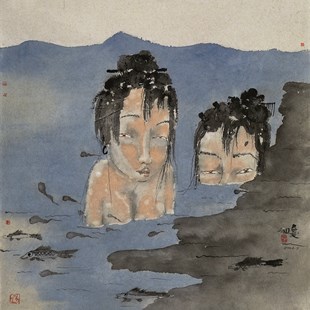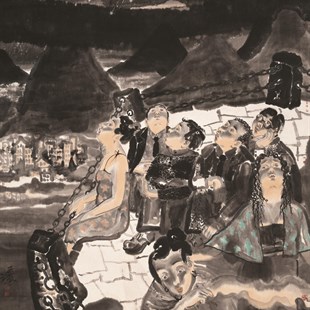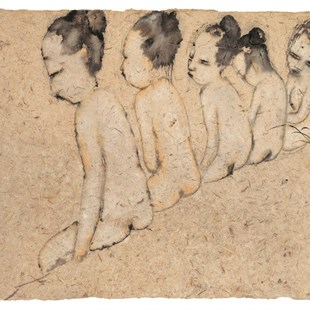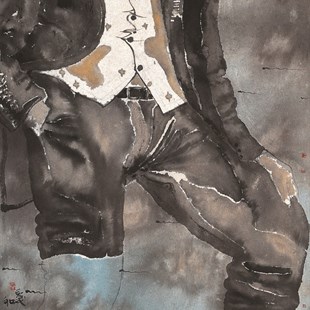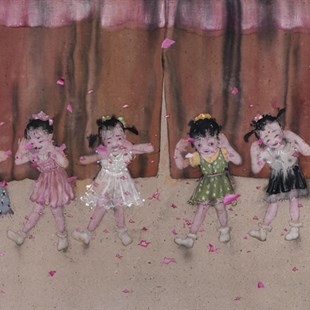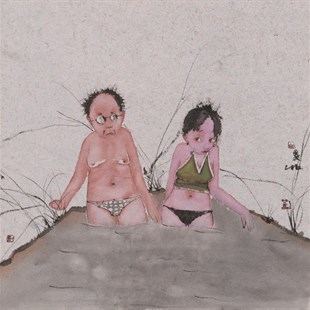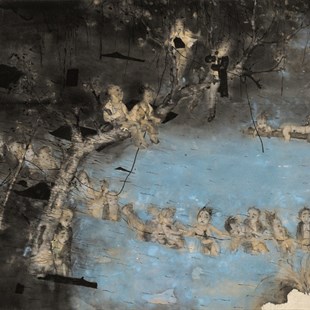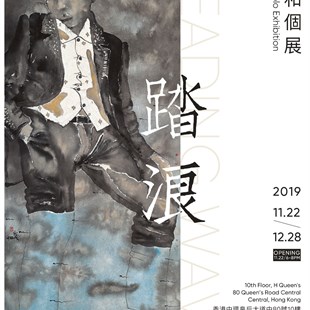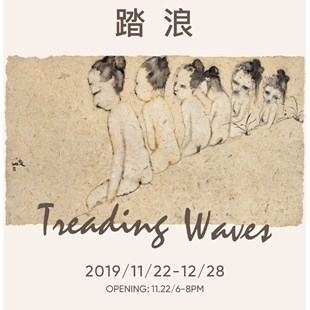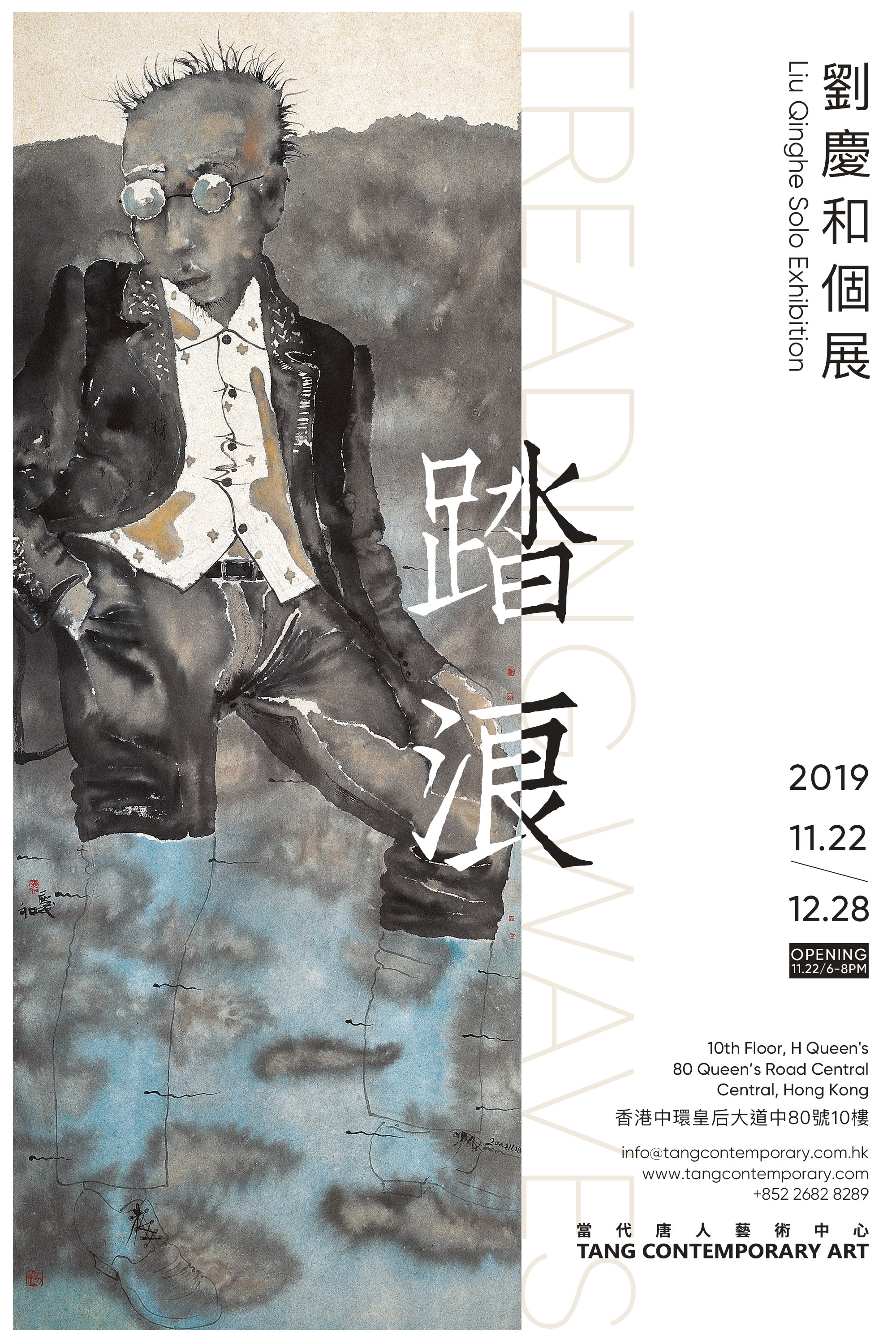
Tang Contemporary Art presents Liu Qinghe’s solo exhibition “Treading Waves,” featuring nineteen of his recent ink on paper works, at the gallery’s Hong Kong space in H Queen’s.
Liu Qinghe is an ink artist with a strong contemporary, experimental sensibility. He focuses on contemporary cities, depicting the visual experiences and psychological perceptions of contemporary people. In the course of his explorations, he dissolves traditional brush and ink modes, creating a unique expressive method that fits with current experience. With unusual sensitivity, he truthfully represents the existential predicaments of people in society, painting a spiritual view of contemporary humanity.
Liu Qinghe maintains the lukewarm attitude to reality that the literati have exhibited since ancient times. He makes his way through life in the city in a leisurely and carefree way. Without adornment and without commentary, he naturally presents the figures’ moods in real life. In his painting, and particularly in his observations of the moods and mentalities of young people, women, and children, he accurately depicts the prismatic reality of contemporary urban life and interprets the spiritual conditions of contemporary people.
In Liu’s ink work, the dripping and permeation of ink construct a space with personal tension, while also effectively playing up the emotional atmosphere. The figures appear in a dense mist of color and ink; the relationship between the figures and their environments create an ineffable, strange ambience. The misty, dense ink reflects the slight unease of contemporary people, and the seemingly casual but meticulous lines suggest the psychological relationships between the figures and the outside world. This ingenious formulation gives Liu’s work a more metaphysical, existential experience.
“Treading Waves” titles after a work in the exhibition. Treading waves is the process of a carefree and positive action, reflecting a graceful, wise attitude. It also highlights the artist’s use of water. Since 2003, this water imagery has become a frequent theme for the artist. Water is treated as the context to envelope isolated individuals and some groups. It is transparent and reflective, which sets off the existence of the figures and their subtle relationships with others. Viewing and perceiving water is a metaphor for real life today. This metaphor concerns the everyday, then presents more real textural and penetrating elements.
Liu Qinghe’s unique contemporary ink is receiving more attention in a globalizing world. He uses brush and ink to create a direct relationship with life today and present viewers with observations and perceptions in ink, a juncture that allows him to re-examine his own life and culture. Liu’s work has always expressed the most authentic feelings and considerations of contemporary life in concrete spiritual images made by a contemporary intellectual.
Purpose
For me, works of art take shape like texts; it’s a random process without a real beginning. Sometimes I feel like a font of creativity, and sometimes I feel blocked. By the time the work is done, what it expresses may have already diverged from my original intention. The advantage of not having a clear thematic direction is that a new direction can, at any time, become a new branch of my work, which can provide a wider range of possibilities. I’m halfway through my life, and feeling lost should essentially be a thing of the past; I had no idea it would still be useful to me now. As someone who is about fifty, at which one “knows the Mandate of Heaven,” I still feel as if I have not passed the stage of “feeling perplexed” at age forty. There are things I want to do and am too lazy to do, but finally have to do. After I’ve done them, I think that I could have done them better, and this feels more like me.
I begin to question whether it was necessary to cover past, mature experiences with new forms. This sense of frustration and exhaustion emerges in the moment that the work is completed, and all I want to do is flee. The timeline of real life is intermittent, and there must naturally be a plausible excuse for linking together these jumbled thoughts, in search of an optimal configuration. Many times, this is what happens; you say it so many times that you start to think it’s true. The exhibition does not appear to be scattered fragments of ideas pressed together to present a period of time or a feeling. What were irreverent or hesitant moods gradually become firmer and more mature.
Defining my work itself is difficult. As the works are generated, they also bring out powers and produce influences, which explain the works themselves. Whether the works are good or bad can be sensed within them, and there is no right or wrong. After all, interpreting works of art and leaving them for others to examine are two different things. There is often a creative intent with a strong sense of responsibility and mission, which can also emphasize the self-aware erosion of creative possibilities and the suspense of a stroke of luck. Every step in the creative process is always taken in pursuit of meaning, and the process becomes a routine formula in search of an answer, without the joy and expansive power that creativity brings us.
Liu Qinghe
April 2019
Written from the T3 International Art District, Beijing
Comments on Liu Qinghe’s Works
Liu Qinghe has retained the indifferent attitude toward reality that the literati have maintained since ancient times—they stand on the margins of reality observing it. As a “person in the know” who also lives in a modern city, he is in the same milieu and can truly appreciate predicaments in modern society, particularly longing, passion, loss, helplessness, and other complex feelings. It is precisely these unusual feelings that give Liu’s art a fresh, contemporary quality. Therefore, his “presence” is not that of an onlooker randomly intervening in a game, but that of a modern man of culture observing the rise and fall of things around him.
Fan Di’an
Through young women soaking in warm waters, Liu Qinghe presents his efforts to retain the life in art, vaguely bringing us into a hallucinatory world; regardless of the mysteries behind the gazes of those women and children, we can look at them and see their intentions. It is worth noting that the images of water and nets are omnipresent in Liu’s work; they express the conflicting desires of imprisonment and liberation, limitation and freedom; any person who is full of ideals yet constrained by reality can see in them the helplessness and hardship of life. In works that have been dubbed “urban ink,” Liu uses the subtle gaze of the figures in his paintings to express some sentimental, unfathomable, and confusing mood that lies beyond the clouds at the horizon. This alone establishes Liu Qinghe’s unique position in Chinese contemporary art.
Yin Shuangxi
Liu Qinghe’s work depicts scenes from contemporary urban life, but it might be better to say that he paints a spiritual picture of contemporary humanity. In his ink works, Liu dissolves traditional brush and ink models without severing the connection to them; he finds in them elements that fit with our current experience, thereby effectively infusing classical sentiment into lonely, powerless figures from our lives today and presenting existential scenes of modern humanity’s spiritual loss. Liu sets a precedent for those who want to bring ink figure paintings into the contemporary realm.
Pi Daojian
In Liu Qinghe’s art, the public and artistic presentation of his private codes and his tenacious transformation of “public” ink escapes the realm of ink in the narrow sense to achieve contemporary meaning. Simply put, its contemporary meaning lies in the intense changes felt by a transforming society, the conflicts between social conformity, mobilization, and stratification, which has provided traditional art with a chance for transformation and embroiled it in unprecedented difficulties in the midst of intense social change. The high degree of integration between art and society turns mass style into a fact and personal expression into a predicament. Liu now stands in this fissure in modern public ink. With the help of divergent reality, he highlights his personal views, recollections, and depictions, transforming public ink into a private joke that makes it contemporary.
Yang Xiaoyan
Liu Qinghe is an artist constantly looking for a breakthrough. Today, the modern youths of northern China that he depicts have already become key symbols in modern ink. Liu’s artistic practice represents the successful transcendence of modern ink, which provides a test case that is worth learning from and one that suggests that contemporary expression in ink painting is not only possible, but has broad scope for operation.
Lu Hong
Liu Qinghe’s visual imagery is very rich in new Chinese and Eastern elements; the calm conceals an inner, restless passion that is contained by, and occasionally revealed by, romantic expression. These passionate narratives also betray a desire to leave the past in the past. An unruliness invades his visual forms, manifested in the enchanting color of water, the blended color of the ink, the admixture of the lines, the intense Eastern tone and Chinese mood, the profoundly meaningful misty background, and the dreamlike, illusory state that the works create, the liberation of a desire about to be satisfied and the impulse of passion, the strength of the brushwork, the preference for line and the pursuit of “bad painting,” and the tendency for boorishness and indulgence on his own paper. These simple forms are also an extension of concept that is diffused in his entire narrative space, releasing an unfettered human nature that pursues freedom and a form of resistance that runs counter to the academic system and various critiques he has received.
Ji Shaofeng
Liu Qinghe’s work undoubtedly faces life squarely, while also stressing reconstructive and imaginative elements. This gives his work some distance and allows them to “escape.” At the same time, there is a mutual confirmation between Liu’s work, in subject and style, and the urban life that he is currently experiencing. Through the establishment of these images, he structures a rather complete system for the current backdrop of our lived environment and culture.
Zhao Li
Liu Qinghe’s art is neither focused on once again establishing the legitimacy of the medium of ink in the contemporary moment, nor on restoring the spiritual foundation of traditional ink in the present through the introduction of the literati spirit. What he pursues is a contemporary mode of expression. In my view, his work is not a compromise between traditional ink and contemporary art; on the contrary, his art does not define him as an “Other” drifting outside the tides of contemporary art. In spirit and essence, he has actively thrown himself into considering reality from the perspective of contemporary art. In both language and spirit, Liu is a unique link between the literati and the humanities.
Pi Li
About the artist
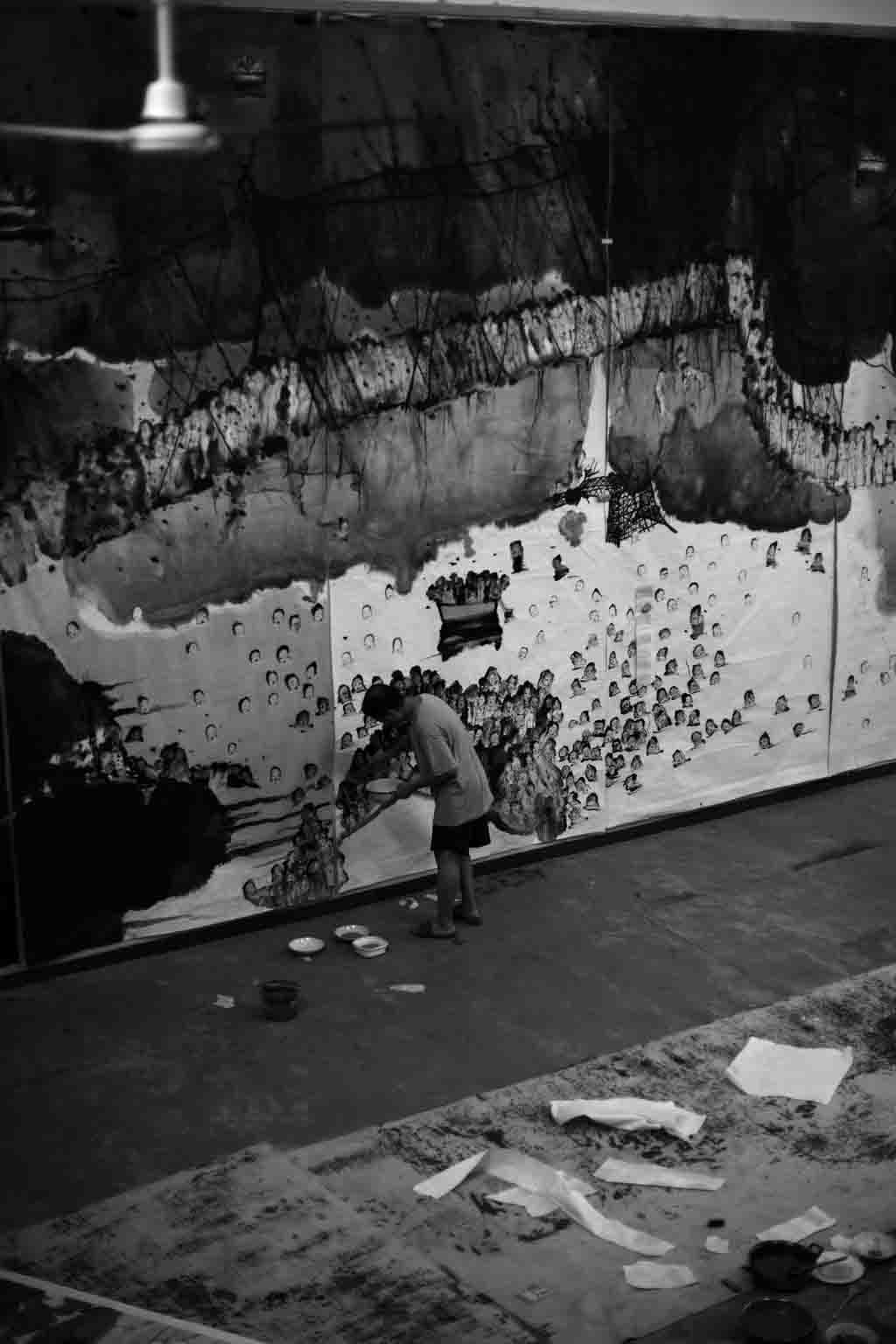
Liu Qinghe was born in 1961 in Tianjin. China. He received degrees from the Tianjin School of Arts and Crafts in 1981, and the Folk Art Department at the Central Academy of Fine Arts in 1987. he received his master’s degree from the Chinese Painting Department at the Central Academy of Fine Arts in 1989. He studied at the Academy of Fine Arts at the Complutense University of Madrid in 1992. He is currently a professor, graduate adviser, and the dean of the School of Chinese Painting at the Central Academy of Fine Arts.
Liu Qinghe has held solo exhibitions at the National Art Museum of China, the Beijing Fine Art Academy Museum, Today Art Museum, He Xiangning Art Museum, United Art Museum, and the University Museum and Art Gallery at the University of Hong Kong. He has also participated in group shows at Kunsthalle Göppingen, Beijing Minsheng Art Museum, Power Station of Art, the Chazen Museum of Art, Cleveland State University, Conde Duque Madrid, and MODEM Debrecen. He was named Ink Artist of the Year at the Eighth AAC Awards, and he won the Shanghai Securities News Annual Golden Artist Prize. L’Officiel Art named him Ink Artist of the Year in 2013. His work has been added to important private and institutional collections around the world.
About the exhibition
Dates: 22 November, 2019 – 28 December, 2019
Venue: Tang Contemporary Art
Courtesy of the artist and Tang Contemporary Art, for further information please visit www.tangcontemporary.com.


